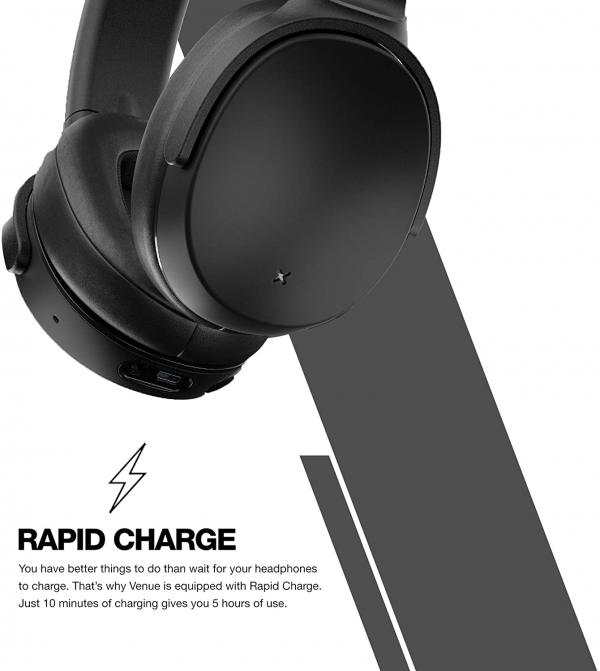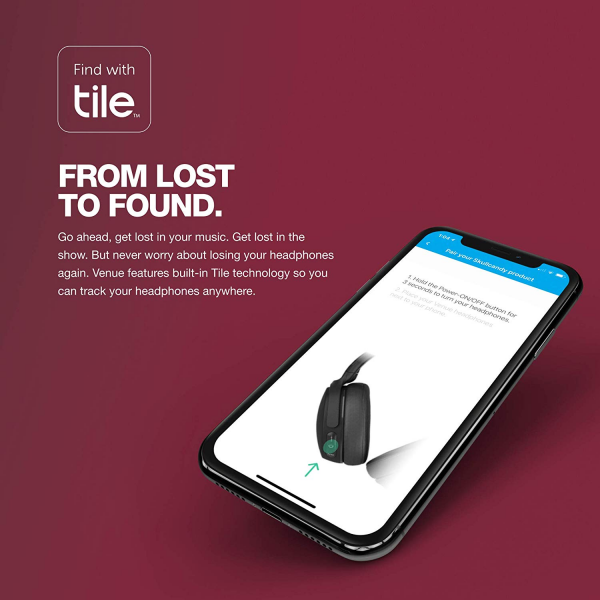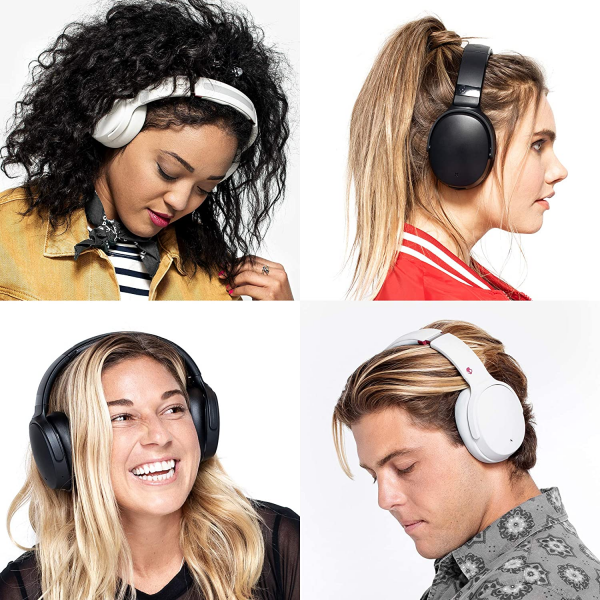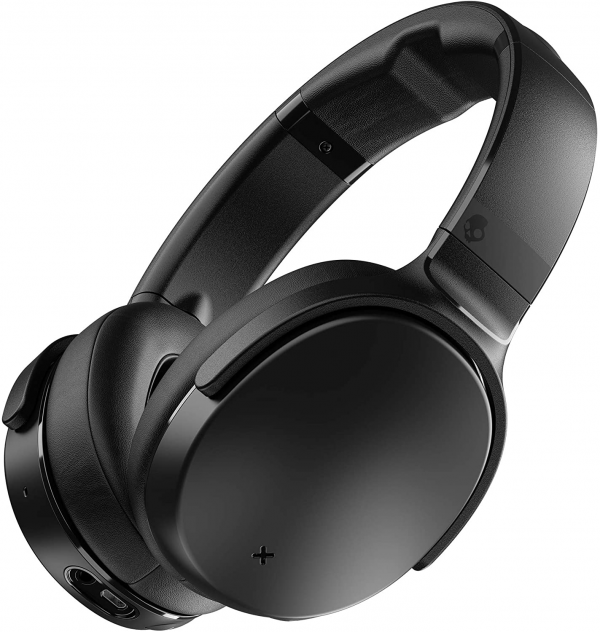Skullcandy
Skullcandy Venue, an ambivalent nomad helmet
Aprox. 129€ - see price -
With the Venue, Skullcandy promises a very complete nomadic model, benefiting from true Bluetooth ergonomics and active noise reduction, but also from fast charging or even the location of the headphones thanks to an integrated Tile tag.
Our review
Ergonomics
All dressed in black or white, the Venue is an over-ear headset with a fairly minimalist design whose membership of the Skullcandy family is only betrayed by the famous skeletal logo at the front of the headband.
The construction as a whole returns an ambivalent feeling of robustness and fragility. The metal core of the headband, its great flexibility and the lightness of the plastic guarantee good resistance, while the rattling, assembly marks and visible screws give the impression of an unfinished task.
The circumaural memory foam closely encloses the pavilions and creates a narrow cocoon, pleasant for small hearing aids, disturbing for slightly larger models. Despite the fineness of the imitation leather lining, the cranial contact proves to be quite comfortable, even for several hours.
The pressure points are distributed homogeneously at the level of the arch, a little less on the side of the temples - phenomenon accentuated for the large skulls in which the auricles tend to stick in front and to yawn slightly in the back. After 2 or 3 hours of wearing, certain morphologies can be inconvenient, even sore at the level of the anthelix. In short, we have known much worse comfort, but we have also known better.
The Venue is not foldable on itself, but the ear cups rotate flat to make it more compact, in the semi-rigid case provided or occasionally around the neck. Counterintuitively, when the helmet is worn flat, the pads and speakers point outward while the shell of the earpieces rests on the user's collarbones. The opposite would have been more comfortable.
The controls are comprehensive, functional and easily identifiable by touch thanks to the different reliefs. On the left is in the middle and in the hollow, the Bluetooth on / off and pairing button (long press when the headset is off), overhung by 4 LEDs indicating the battery status (simple press on the main button) and the headset mode (Bluetooth / wired / ANC). Below, the letters ANC mark the on / off command for active noise reduction - a short press to switch between noise reduction and listening to the environment, a long press to deactivate the microphones and switch to passive isolation. As often, the other headset accommodates the volume adjustment, the play / pause, the passage to the next / previous track (double / triple press on the central button), the answer / reject of calls and the invocation of the assistant (long press). The multipoint Bluetooth connection is there, making use even more fluid: it is possible to connect simultaneously to two sources (his smartphone and his computer, for example), the last device launching a reading automatically taking the hand (this which also works for calls ).
Thanks to the analog input and the supplied mini-jack cable, the user can prefer the wired connection to Bluetooth, or fall back on it in the event of a breakdown. Note that the active features remain operational, even when the connection is wired. Next to it is the micro-USB charging port, the battery offering the headset 26 hours of autonomy with all options activated, and more than 35 hours only in Bluetooth (without active noise reduction). Note also that 10 minutes of charging guarantees no less than 5 hours of autonomy, a promise that we have verified at 75% of the maximum volume with RBA.
Latency, measured at 200 ms, induces a noticeable lag when watching videos. There is no latency compensation on compatible applications (Netflix, YouTube).
The hands-free kit is surprisingly effective for this type of model: the user's voice seems much less "underwater" than usual, the timbre is better respected, and the words are quite understandable, even in noisy environment.
The integrated Tile tag makes it possible to geolocate the Venue and, when its owner is nearby, to find it thanks to an acute sweep diffused by the loudspeakers of the helmet. Note that the helmet itself does not carry a GPS: its position is saved each time the Tile application is opened, which is why it is recommended to leave it running in the background. Furthermore, if you believe in humans, you can also count on the Tile community: if another user's application passes in front of your lost object, you will be instantly informed of its position.

Audio
With or without noise reduction, the Venue benefits from a nice extension in the bass (clearly noticeable from 30 Hz). The rendering with RBA and in passive isolation clearly signs in V. The bass, very round and lacking in control, is quite sluggish (feeling of pressure with certain games / instruments - double bass pizzicato, kick). The low mids benefit from a level capable of offering an appreciable sound immersion, but also suffer from a lack of precision causing a certain confusion, comparable to a slightly muddy side when the mix is particularly active in this region. In general, there is a slight distortion of the mids as well as a "compactness" of the mix (difficulty in discerning the different layers), however the different sound speakers (instruments, noises, voice) remain despite everything very identifiable and differentiable. Voices in particular benefit from a clear presence and good intelligibility. The high mids and highs are highlighted, with a tendency to hissing (in the sense of the sound "ch", not whistling), without going as far as wheezing. The fricatives and the acute percussions come out of the mix ("pssht pssht") without attacking the eardrum. You can for example listen to voice content (radio broadcasts, audio books, etc.) without ever being disturbed by whistling.
The power of the helmet once the RBA is activated or in passive isolation is very good, more than enough for mobile use. Listening to the environment, the level is drastically reduced: at maximum amplification volume and 0 dB FS, the speakers reach 87 dB SPL. Active noise reduction distortion goes up a notch, flirting throughout the spectrum with 0.5% and even climbing to the 1% threshold between 4 and 5 kHz. Note that the harmonic distortion rate is identical in wire.
If in view of the lack of homogeneity of the attenuation throughout the spectrum, the RBA is not here up to that of a PX, it is nonetheless quite efficient on the first part of the spectrum - engine noise, urban hubbub. As can be seen on the curves above, the algorithm chooses to make the voices more perceptible than in passive isolation: the Venue is therefore quite capable of cutting the majority of the deaf noises of a noisy environment, but leaves the surrounding conversations perceptible. Listening to the environment, the quality of which frequently goes hand in hand with that of RBA, is rather discreet but functional: far from the usual acid pitfall, the rendering is natural, airy without being aggressive, fairly realistic at all along the spectrum. Alas, in listening to the outside as in active noise reduction, the Venue has a fault, and not least: it is extremely sensitive to wind noise. The slightest breeze, and the helmet turns into a RATP driver's microphone.

Conclusion
Regarding its promises, Skullcandy makes a flawless one: the use in wireless, the reduction of active noise, the autonomy and the localization of the headphones are all successes, just like the good quality of the kit hands- free, the natural of listening to the environment and the highly practical multipoint connection. On the other hand, notable ergonomic and audible defects considerably tarnish the table, lowering the rating to 3 stars.

Reviews


Great sound and price.
In my search for a good set of noise cancelling (NC) cans I realized that I am NOT an audiophile so take what you want from my review. This is probably a review of 4 different headphones.
I've tried and returned the Bose QCI, Beats Studio3, and Bowers and Wilkins PX. In my opinion, the Venues are the best bang for your buck and here's why - these are half or less than half the price of the Bose, Beats, and Bowers cans.
I was looking for a good pair of NC for flights / traveling / home use. I first tried the Bose QC 35I side by side to the Beats Studio 3 and there was no contest - Bose was definitely better as the Beats could be too airy / the mix could muddle up depending on the song / volume. Listening to the same songs side by side you would get more detail with the Bose. NC on both was pretty good. However, it wasn't until I took a 2 hour flight that the reality of NC tech hit me. It's just not perfect yet so you have to set your expectations. With the Bose, if you do not have a good seal (wearing glasses or a baseball cap), you will have sound leakage. Also, you'll still hear faint voices, flight attendants over the speakers. To get the same oomph you would need to turn your volume higher. Also, be careful when landing because if you don't have a good seal the Bose algorithms get confused and you get a weird sound when the plane makes touchdown due to the increase in volume. This was enough for me to return them. At $ 349, these should work better.
I next tried the Bowers & Wilkins PX over a weekend ($ 390). Soundstage was great (but bass was lacking in my opinion) and the different NC modes were neat (Off, Office, City, Plane). Noise canceling was great too but the app was very slow. Each time you wanted to try a new setting, the app would have to start over and find your headphones again. That and the fact that the headphones would give the top of my head some discomfort each time was enough to turn these in.
The Venues are really light and comfortable so they beat the Bowers there and are by with Bose. There's no app so you do it all by the buttons (once you get used to the controls, it's easy), but they do have Alexa / Google / Siri functionality and tile tracking, which in my opinion makes them better than the other two. They also have quick charge (5-10 mins gives you 5 hours). Yes they have more bass, but the mix sounds really good and significantly better than the Beats. They aren't as crisp as the Bose or as expansive a soundstage as the Bowers, but they do have that oomph that makes your head nod with the music. I really like the sound in these.
Noise Canceling - good enough for me so far. I tried them out at home and couldn't hear the tv or washer / dryer. I'll be putting these through more use and will update this review if anything changes.
Really good but not amazing
I've worked in audio production for about a decade now, and while I never use headphones for audio work, I do have an experienced ear. These headphones sound pretty good with all genres of music. Compared to Bose, they are very close in clarity - but the Venue has more bass. And by more bass, I really just mean that they render the bass exactly the way it was mixed and should sound. With active noise cancelling (ANC) on, the audio quality takes a slight dip, but it still sounds great. They are light weight and very comfortable. The build quality is pretty solid.
As far as the ANC, it works well. It won't cut out conversations or noise completely, but it does thin them out to the extent that outside noise won't be too distracting. With ANC on the volume takes a bit of a dip. I experienced no noise or buzzing issues what-so-ever with ANC on. I expected a bit more noise cancellation but for this price range, I would say they are about right. The $ 370 Bose headphones have amazing ANC but I can't justify spending that much on a pair of headphones.
The headphones come with a nice firm carrying case, aux cable, and USB charging cord. The headphone buttons are pretty straight forward and you will get a handle on them after a few minutes.
The battery life has been great.
Update: The more I listen to these the more I like them. The ANC is actually really good and the sound quality continues to surprise me - really detailed audio.
These are ABSOLUTELY FANTASTIC!!!
So let me start off by saying I did not buy this product on Amazon because I couldn't wait for it to get here. Instead I bought it off Skullcandy website the day they released it. Now that it is here however I'll still write this review.
Build quality: 7.5 / 10: not cheaply made but also not built like a tank. Will take more than a drop or couple bends to break this product but still be careful.
Comfort: 9/10: earpads could be sightly more open for larger ears but for me with average size ears they are perfect. Soft, plush and completely engulfing. I love how these fit and feel. One of the most comfortable pairs of headphones I've ever worn with perfect clamping force. Not to much and not to little.
Looks: 10/10: in my opinion they are beautiful. Slick and sleek. I love them.
Features: 10/10: they do and have just about everything you need in a pair of headphones. Anc, mic, play, pause, volume, Skip and go back tracks, take calls, monitor mode, battery indicator, quick charge, tile with app built in for if you lose them. They have everything and they do it all very well. Couldn't ask for more. Perfect.
ANC: 9/10: I'm not rating this for comparison to every pair of headphones out there top and low end. I'm writing this for the $ 200 be and below range. The ANC is actually very very good. I've tried literally close to a hundred headphones with ANC in the under $ 200 range and these are right up there with the best. A slight, very low and hardly noticable hiss is present when ANC is on with no music or volume playing but as soon as you turn up the volume for audio even 1 click it goes away. There is zero cabin pressure which some other headphones will make you experience with ANC on. With ANC on I'd say legit all ambient noise is cut down by 95% and voices are cut down a good 80%. The ANC is impressive on these for the price for sure. Id say in the top 5 headphones with anc for all time under $ 200.
tidy. Also, the ANC does not effect the sound signature what so ever.
Now for the sound which is completely subjective and different for everyone. This is solely my opinion and what it is for me personally.
Sound: 9.5 / 10: highs and mids are Crystal clear and present with a deep, low and rumbly bass that does not bleed into the treble what so ever. I am in love with the sound of these. They are kind of like a crossbreed between the hesh 3 and crusher wireless (which I love both). The sound is very impressive on these. My only gripe is I wish they went about 1 or 2 clicks louder but that's a small issue that actually becomes completely null and void once anc is activated. It locks you in your own little world. The sound is damn near perfect for me for not being an open back audiophile type headphone.
All in all Skullcandy is stepping they're game up hard and absolutely nailed it with these headphones. I wear them all day and hate taking them off. I love them. Way to go Skullcandy.